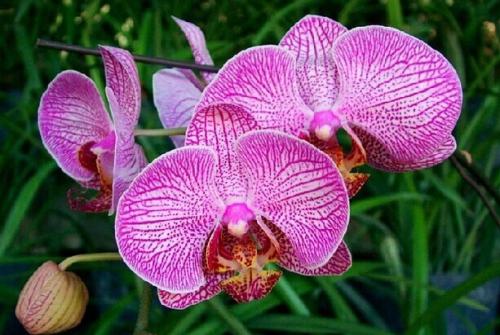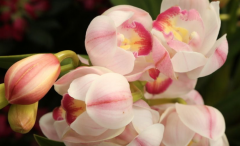Phalaenopsis winter maintenance: what is the cold damage of Phalaenopsis? Differences in diseases among different varieties
In the phenomenon of cold injury of Phalaenopsis, the symptoms of cold injury were slightly different among different varieties. What is the cold damage of Phalaenopsis? do you want to know?
The variety of safflower Phal. Taisuco Firebird as the experimental material, imitating the way of routine export packaging, put the plant in a white paper bag, picked flat, and packed it into a cardboard box, using 12, 14 and 16 ℃ to simulate five treatments such as dark and low temperature shipping for one to five weeks, and then placed in a flowering greenhouse with a daily temperature of 25 ℃ and a night temperature of 18 ℃ for flowering treatment. Control 2 was placed in flowering greenhouse. After the stem flowering, the flowering characters were investigated.
Phalaenopsis plants were treated with dark and low temperature in this experiment, and all kinds of cold injury occurred. After induction, it can be divided into 6 grades (0 normal, 1 slightest, 3 mild, 5 moderate, 7 serious, 9 most serious), grade 0 is no cold injury at all; grade 1 is a slight infiltration in the leaves of some plants, which usually occurs only in one leaf. Grade 3 is that the leaves produce obvious water-immersed black-brown round plaques, and the disintegration and necrosis can be clearly seen in the plaque; if the water-immersed black-brown necrotic tissue extends to more than half of the area of the leaves, and each leaf will occur, the grade is summarized as level 5. The plant cold injury of grade 7 has been quite serious, the water-immersed necrotic tissue has expanded to most of the leaf area, and the leaves of the plant have mostly softened and drooped. When the cold injury grade is grade 9, all the leaves of the plant are immersed and softened with the infection of miscellaneous bacteria, the base of the leaf falls off, and the plant can not stand upright at all.
The symptoms of cold injury were slightly different among different varieties. the diffusion of water-immersed black-brown necrotic tissue in the leaves of some varieties was often accompanied by the occurrence of peripheral yellow halo, which seemed to be the reaction of some kind of cold protection mechanism, so when the cold injury grade was 7, the plant was still in a upright state. According to the above cold injury grades, the actual investigation results are shown in Table 1, which shows that the Phalaenopsis variety Taisuco Firebird is treated by simulated basin dark low temperature shipping for one to five weeks at the temperatures of 12, 14 and 16 ℃. The investigation results show that there is no cold injury in the two control plants without low temperature treatment. There were different degrees of cold injury symptoms in the simulation process at 12 and 14 ℃. The cold injury at 12 ℃ was more serious than that at 14 ℃. The longer the shipping weeks, the more serious the cold injury, and even all the plants of the whole treatment were rotten to death. However, after five weeks of dark and low temperature at 16 ℃, there was no obvious cold injury, and only a few plants had slight macular cold injury. After moving into the flowering greenhouse, all the plants treated with 12 ℃ were rotten and had no cultivation value at all. The plants treated with 14 ℃ varied according to the number of weeks of treatment, 50% and 100% of the plants had cultivation value, and the plants of 16 ℃ had 100% cultivation value.

- Prev

Is Cymbidium a kind of Cymbidium? The hanging orchid is sedge orchid.
What is the orchid? is the orchid a kind of Cymbidium? In fact, it is not, the weeping orchid is an orchid variety, does not belong to the cymbidium, it is a single orchid variety, orchid epiphytic herb, because its flowers are drooping, so it is called weeping orchid. Drooping flower
- Next

Xishen 2018 wishes you all a happy New year!
The classic variety of Xishen Chunlan is worth nourishing and has a good fragrance. This is the beginning of 2018 to share with orchid friends!
Related
- Is the orchid suitable for indoor use? Is it good for the body?
- How to prevent the empty root of orchids?
- What to do after the crab claw orchid is withered?
- Why are the leaves of orchids always yellow? Fertilizing and watering.
- Can the root of the gentleman orchid be saved if it is rotten?
- Diagnosis and treatment of cotton-blowing beetle insects in Cymbidium
- There is a way for a gentleman's orchid to rot.
- What is the most suitable temperature and humidity for the orchid?
- How to raise a gentleman's orchid? Cultivation techniques of Cymbidium
- How to prepare the nutritive soil for the cultivation of Cymbidium

